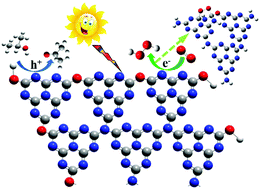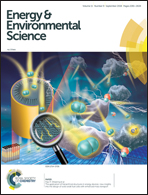Efficient visible-light-driven selective oxygen reduction to hydrogen peroxide by oxygen-enriched graphitic carbon nitride polymers†
Abstract
H2O2 is a green, environmentally friendly potential energy source. The photocatalytic reduction of molecular oxygen to synthesise H2O2 is an eco-friendly strategy compared with the anthraquinone method and H2/O2 direct synthesis. We proposed oxygen-enriched carbon nitride polymer (OCN) models, which were proven to more easily produce 1,4-endoperoxide species and have a high selectivity for molecular oxygen reduction to H2O2, rather than superoxide radicals, through theoretical calculations and experiments. The apparent quantum yield for H2O2 production by OCNs reached 10.2% at 420 nm under an O2 atmosphere, which was 3.5 times higher than that of g-C3N4 and the activity did not decay over 20 h. OCN has a better oxygen reducibility and electron–hole separation efficiency than g-C3N4 and is more prone to 2-electron reduction in the ORR. This work promotes understanding of the mechanism of photocatalytic oxygen reduction and provides a new idea for the design and synthesis of new materials for the preparation of H2O2.



 Please wait while we load your content...
Please wait while we load your content...